

Towardsdatascience. ‘OpenAI should be renamed ClosedAI’: Reaction to Microsoft’s exclusive license of OpenAI’s GPT-3 - GeekWire. Microsoft this week gained an exclusive license to OpenAI’s GPT-3, the state-of-the-art language model garnering attention across the tech industry.

Other companies will still be able to access the model through an Azure-hosted API, but only Microsoft will have access to GPT-3’s code and underlying advances. The deal follows Microsoft’s $1 billion investment last year in San Francisco-based OpenAI, which consists of the OpenAI Inc nonprofit founded four years ago and the for-profit OpenAI LP.
The implications of giving a tech giant such as Microsoft an exclusive license to GPT-3 raises questions and potential concerns. MIT Technology Review said this week that OpenAI was “supposed to benefit humanity,” and now “it’s simply benefiting one of the richest companies in the world.” The GPT-3 economy – TechTalks. This article is part of our series that explore the business of artificial intelligence Since its release, GPT-3, OpenAI’s massive language model, has been the topic of much discussion among developers, researchers, entrepreneurs, and journalists.
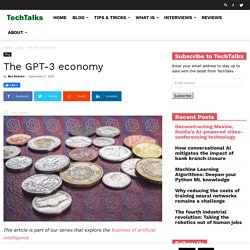
Most of those discussions have been focused on the capabilities of the AI-powered text generator. Users have been publishing the results of interesting experiments using the AI to generate anything and everything from articles to website code. Google Open-Sources LIT: A Visual, Interactive Model-Understanding Tool For NLP Models. Evaluation of Sentiment Analysis: A Reflection on the Past and Future of NLP. I recently received a new paper titled“Evaluation of Sentiment Analysis in Finance: From Lexicons to Transformers” published on July 16 2020 in IEEE.
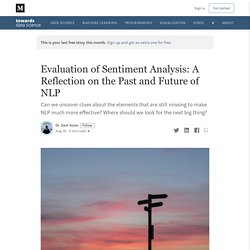
The authors, KostadinMishev, Ana Gjorgjevikj, Irena Vodenska, Lubomir T. Chitkushev, and DimitarTrajanov compared more than a hundred sentiment algorithms that were applied on two known financial sentiment datasets and evaluated their effectiveness. Although the purpose of the study was to test the effectiveness of different Natural Language Processing (NLP) models, the findings, in the paper, can tell us much more, about the progress of NLP over the duration of the last decade, especially, to better understand what elements contributed the most to the sentiment prediction task. So let’s start with the definition of the sentiment prediction task. Natural Language Processing (NLP) with Python — Tutorial. Natural Language Processing, Scholarly, Tutorial Tutorial on the basics of natural language processing (NLP) with sample coding implementations in Python Author(s): Pratik Shukla, Roberto Iriondo Last updated, July 26, 2020.

Online Course on Natural Language Processing by deeplearning.ai: Registrations Open - Noticebard. Break into the NLP space.
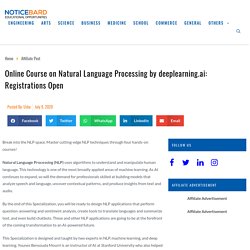
Master cutting-edge NLP techniques through four hands-on courses! Natural Language Processing (NLP) uses algorithms to understand and manipulate human language. This technology is one of the most broadly applied areas of machine learning. As AI continues to expand, so will the demand for professionals skilled at building models that analyze speech and language, uncover contextual patterns, and produce insights from text and audio.
By the end of this Specialization, you will be ready to design NLP applications that perform question-answering and sentiment analysis, create tools to translate languages and summarize text, and even build chatbots. This Specialization is designed and taught by two experts in NLP, machine learning, and deep learning. What you will learn Courses in this specialisation Prerequisites Duration Approx. 4 months to complete Suggested 4 hours/week For full details and to enroll for this course, click the link below. Natural Language Processing Pipeline. If we were asked to build an NLP application, think about how we would approach doing so at an organization.
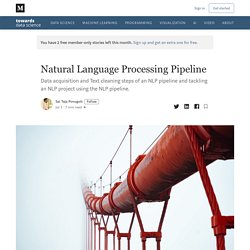
We would normally walk through the requirements and break the problem down into several sub-problems, then try to develop a step-by-step procedure to solve them. Since language processing is involved, we would also list all the forms of text processing needed at each step. This step-by-step processing of text is known as a NLP pipeline. It is the series of steps involved in building any NLP model. Facebook's TransCoder AI converts code from one programming language into another. Facebook researchers say they’ve developed what they call a neural transcompiler, a system that converts code from one high-level programming language like C++, Java, and Python into another.

It’s unsupervised, meaning it looks for previously undetected patterns in data sets without labels and with a minimal amount of human supervision, and it reportedly outperforms rule-based baselines by a “significant” margin. Migrating an existing codebase to a modern or more efficient language like Java or C++ requires expertise in both the source and target languages, and it’s often costly.
For example, the Commonwealth Bank of Australia spent around $750 million over the course of five years to convert its platform from COBOL to Java. Facebook’s system — TransCoder, which can translate between C++, Java, and Python — tackles the challenge with an unsupervised learning approach. Facebook isn’t the only organization developing code-generating AI systems.
Time to get hacking! @huggingface just released an NPM package for question answering using #DistilBERT directly in #NodeJS with a 2x performance boost over Python. #madeWithTFJS #JavaScript… Facebook AI sur Twitter : "We're releasing mBART, a new seq2seq multilingual pretraining system for machine translation across 25 languages. It gives significant improvements for document-level translation and low-resource languages. Read our paper to lea. □ The Best and Most Current of Modern Natural Language Processing. Over the last two years, the Natural Language Processing community has witnessed an acceleration in progress on a wide range of different tasks and applications. 🚀 This progress was enabled by a shift of paradigm in the way we classically build an NLP system: for a long time, we used pre-trained word embeddings such as word2vec or GloVe to initialize the first layer of a neural network, followed by a task-specific architecture that is trained in a supervised way using a single dataset.

ScatterBlogs - Visual Social Media Analytics. SDR Deposit of the Month: Dissertation on AI breakthrough makes leaderboard. Occasionally I review the analytics for content published via the Stanford Digital Repository to see what is currently trending.

Upon returning to my Lathrop desk in January after the recent winter break, I checked in and discovered that a dissertation submitted last month by student Danqi Chen had enjoyed a whopping 2,736 pageviews in just four weeks since it was published on December 11, 2018. That is an extraordinarily impressive number! I had to find out why this publication was of such widespread interest. Chen’s work is titled, Neural Reading Comprehension and Beyond, and describes her research to address "one of the most elusive and long-standing challenges of artificial intelligence”: teaching machines to understand human language documents. A quick Google search revealed that the news about Chen’s exciting research spread quickly via Twitter and other newsfeeds devoted to machine learning topics. LSTMs Can Learn Syntax-Sensitive Dependencies Well, But Modeling Structure Makes Them Better (ACL 2018) - The Stanford Natural Language Processing Group. Welcome to the Stanford NLP Reading Group Blog!
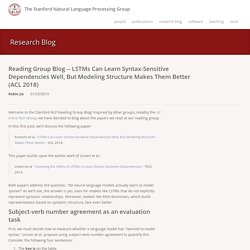
Inspired by other groups, notably the UC Irvine NLP Group, we have decided to blog about the papers we read at our reading group. LSTM-Classification/calculate_word_dictionary.py at master · pinae/LSTM-Classification. ML Universal Guides Expert System: Artificial Intelligence: Cognitive Computing Company. Es ist nun fast schon ein halbes Jahrzehnt vergangen, seit IBM mit seinem Computersystem namens Watson in der Fernseh-Show Jeopardy angetreten ist. Das Ziel der Sendung ist es, aus einer gegebenen Antwort die semantisch dazu passende Frage zu stellen, und Watson schlug hier zwei menschliche Teilnehmer, die in der Show bereits gewonnen hatten, um Längen.
Auch im heutigen Journalismus ist die Unterstützung durch Textanalyse-Verfahren nicht mehr wegzudenken. So werden Redakteure durch die automatische Identifikation von Schlüsselwörtern bei der Verschlagwortung ihrer Artikel unterstützt. Ebenso lassen sich mit dieser Technologie Themenseiten vollkommen automatisiert erstellen, so dass sich z.B. alle Nachrichtenbeiträge verschiedener Anbieter gebündelt darstellen lassen.
Die maschinelle Auswertung von natürlicher Sprache hat dabei in der Forschung eine längere Tradition als viele vermuten. Seitdem hat sich die maschinelle Sprachanalyse in der Wissenschaft kontinuierlich weiterentwickelt. Peter Kolb Homepage: Linksammlung freie NLP-Software für das Deutsche. Stanford CoreNLP.